Cajón
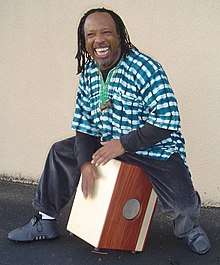
A cajón (Spanish: [kaˈxon]; "box", "crate" or "drawer") is a box-shaped percussion instrument originally from Peru, played by slapping the front or rear faces (generally thin plywood) with the hands, fingers, or sometimes various implements such as brushes, mallets, or sticks. Cajones are primarily played in Afro-Peruvian music, as well as contemporary styles of flamenco and jazz among other genres.[1] The term cajón is also applied to other box drums used in Latin American music such as the cajón de rumba used in Cuban rumba and the cajón de tapeo used in Mexican folk music.
Description
Sheets of 0.5 to 0.75 inches (1.3 to 1.9 cm) thick wood are generally used for five sides of the box. A thinner sheet of plywood is nailed on as the sixth side, and acts as the striking surface or head. The striking surface of the cajón drum is commonly referred to as the “tapa”. A sound hole is cut on the back side. The top edges are often left unattached and can be slapped against the box.[2] The modern cajón may have rubber feet, and has several screws at the top for adjusting percussive timbre.
Originally the instruments were only wooden boxes, but now some versions may also have several stretched cords pressed against the top for a buzz-like effect or tone. Guitar strings, rattles or drum snares may serve this purpose. Bells may also be installed inside near the cords. The instruments are available in a wide range of finishes and price points, ranging from relatively affordable DIY kits to costly handcrafted models.
Origins and evolution
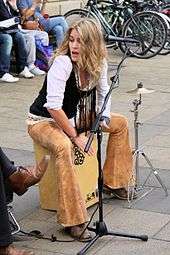
The cajón is the most widely used Afro-Peruvian musical instrument since the late 16th century.[3] Slaves of west and central African origin in the Americas are considered to be the source of the cajón drum. Currently, the instrument is common in musical performance throughout some of the Americas, the Philippines and Spain. The cajón was developed during the periods of slavery in coastal Peru. The instrument reached a peak in popularity by 1850, and by the end of the 19th century cajón players were experimenting with the design of the instrument by bending some of the planks in the cajón's body to alter the instrument's patterns of sound vibration.[3] After slavery the cajón was spread to a much larger audience including Criollos.
Given that the cajón comes from slave musicians in the Spanish colonial Americas, there are two complementary origin theories for the instrument. It is possible that the drum is a direct descendant of a number of boxlike musical instruments from west and central Africa, especially Angola, and the Antilles. These instruments were adapted by slaves from the Spanish shipping crates at their disposal.[4] In port cities like Matanzas, Cuba, codfish shipping crates and small dresser drawers became similar instruments. Another theory is that slaves used boxes as musical instruments to subvert Spanish colonial bans on music in predominantly African areas;[5] In this way, cajones could easily be disguised as seats or stools, thus avoiding identification as musical instruments. In all likelihood it is a combination of these factors - African origins and Spanish suppression of slave music - that led to the cajón's creation.
Spanish flamenco guitar player Paco de Lucía brought to Spain a cajón formerly owned by Peruvian percussionist Caitro Soto in 1977 with the purpose of using it as a more reliable rhythmic base in Flamenco.[6] In 2001, the cajón was declared National Heritage by the Peruvian National Institute of Culture.[7] In 2014, the Organization of American States declared the cajón an "Instrument of Peru for the Americas".[8]
Contemporary music
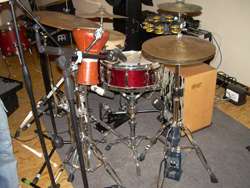
In the 2000s (decade), the cajón is heard extensively in Coastal Peruvian musical styles[9][10] such as Tondero, Zamacueca and Peruvian Waltz, Spanish modern Flamenco and certain styles of modern Cuban Rumba. The modern cajón is often used to accompany a solo acoustic guitar or piano. The cajón is becoming rapidly popular in blues, pop, rock, funk, world music, jazz, etc. The cajón is often used as a bass drum by bands instead of a full drum kit when performing in minimalist settings, as the cajón can simultaneously serve as both a bass drum and a seat for the drummer. Though occasionally played by some bands in place of the bodhrán, the cajón has not become a popular instrument in the folk music of Ireland, where the quieter and higher-pitched bodhrán traditional frame drum serves the same purpose, and has a unique playing style. The cajón also features in some Breton music.
Playing styles
The player sits astride the box, tilting it at an angle while striking the head between their knees. The percussionist can play the sides with the top of their palms and fingers for additional sounds. Some percussionists attach a bass drum pedal to the instrument, enabling them to play it with a single foot.
The instrument has been played not only with hands, but also with plastic and metal brushes, as used for drum kits. Another way of playing the cajón is to use an ordinary bass drum pedal, thus turning the cajón into an indirect percussion instrument which can be played with the feet. This enables the player to beat it just like a pedal-bass drum, thus leaving the hands (and one other foot) free to play other instruments. On the other hand, it also restricts the player's standard cajón-playing position, as when the cajón is placed on the ground, in the bass drum location, it is hard for the performer to slap it with her or his hands.
Gallery
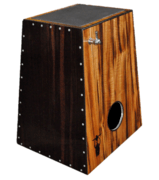
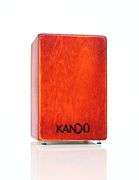
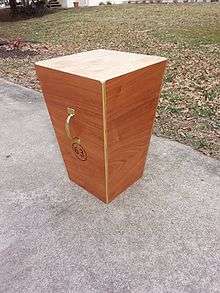
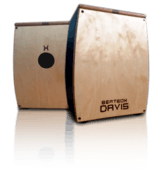
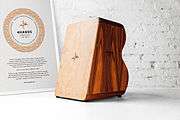
See also
| Wikimedia Commons has media related to Cajon. |
- Afro-Peruvian music
- Jawbone (instrument)
- Festejo
- Flamenco
- Cajón de rumba - Cuba
- Cajón de tapeo - México
References
- ↑ Chuse, Loren (2003). Cantaoras: Music, Gender and Identity in Flamenco Song. New York, NY: Routledge. p. 50.
- ↑ http://www.thecajondrumshop.com/index.php?page=how-to-build-a-cajon The Cajón Drumshop, How to build a cajón
- 1 2 Tompkins, William David: "Afro-Peruvian Traditions" in "Music of the African Diaspora in the Americas," p. 493. Springer US Press, 2005
- ↑ Feldman, Heidi: "Black Rhythms of Peru" p. 21-22. Wesleyan University Press, 2006
- ↑ Feldman, Heidi: "Black Rhythms of Peru" p. 22. Wesleyan University Press, 2006
- ↑ https://www.youtube.com/watch?v=LCNEpVmrJsM The origins of Peruvian Cajón in Flamenco, Paco de Lucia interview
- ↑ "National Directoral Resolution 798 August 2 2001".
- ↑ "Secretary General Insulza Welcomed Musician that OAS will Pay Tribute to in a Ceremony to Declare the Peruvian Cajón as "Instrument of Perú for the Americas"". Organization of American States. 30 October 2014. Retrieved 16 December 2015.
- ↑ https://www.youtube.com/watch?v=Z7Py45ktc34&list=UU7SqX8W4D1rWh3G6PSSa3SA&index=4 Festejo music
- ↑ Feldman, Heidi: "Black Rhythms of Peru". Wesleyan University Press, 2006